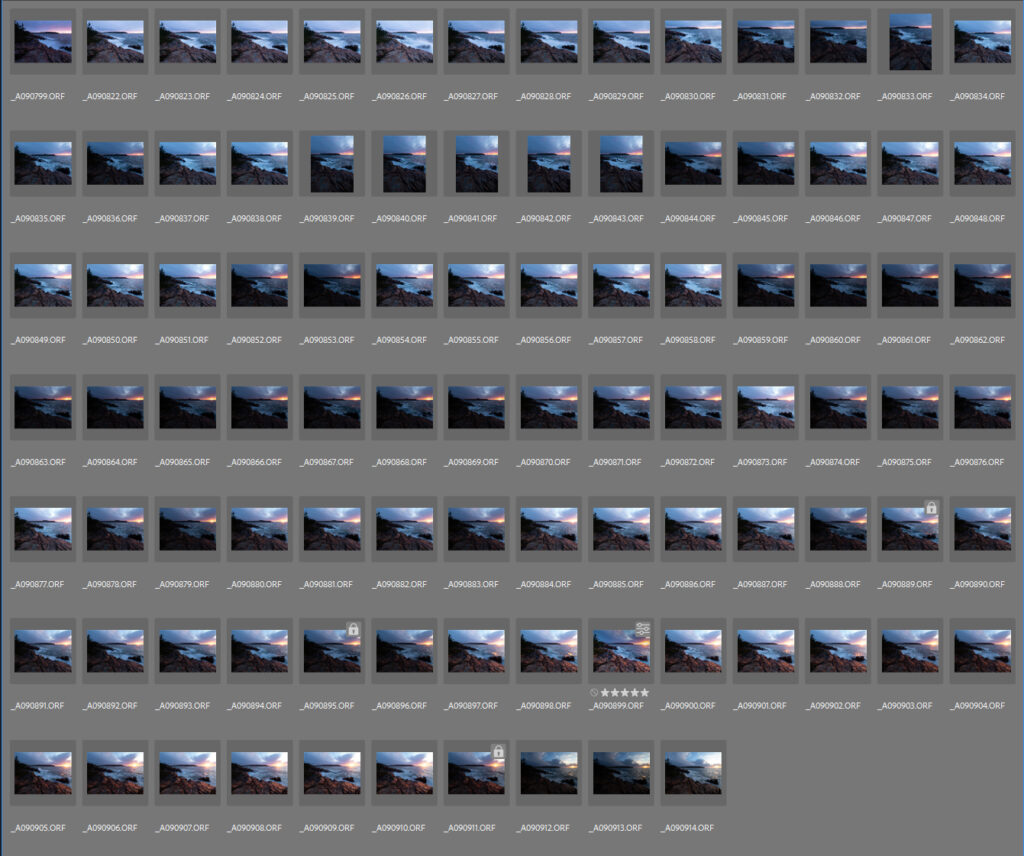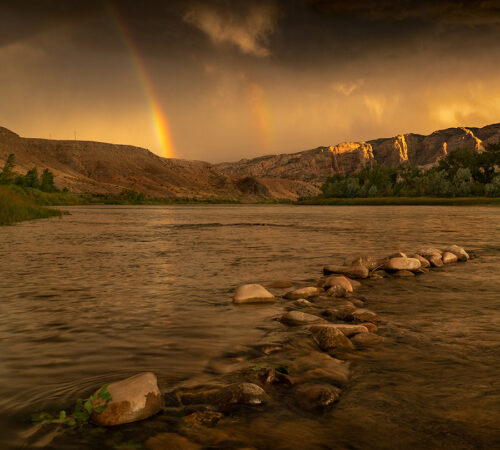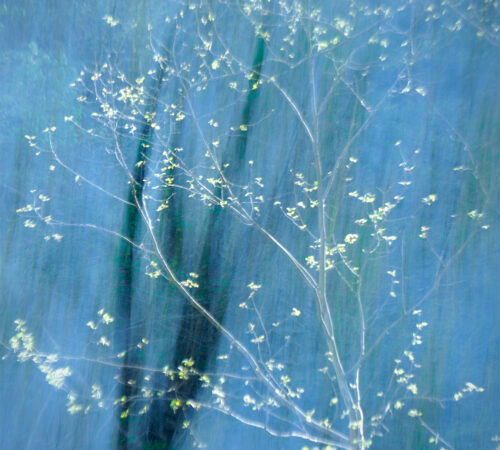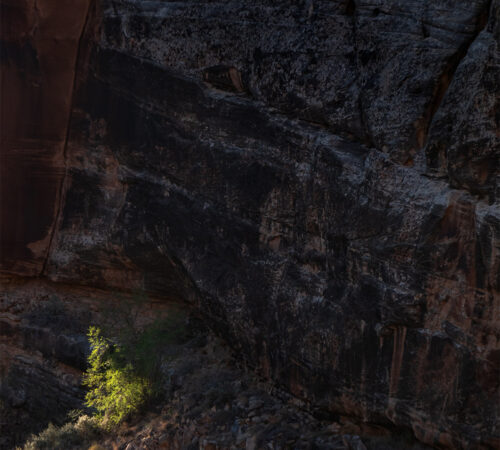Searching for “The One”

Dear Bubbles:
How do you go about picking “the one” out of a series of photographs (like when you photograph moving waves)?
-Team Chaos
Dear Team Chaos:
First, thanks so much for joining me on my recent Autumn in Acadia photography workshop (session #1). I’m not exactly sure what awesome things occurred during the carpools for you to name yourselves “Team Chaos,” but it must have been hilarious. All four of you, and your six other trip mates, were absolute delights to be around for the week.
Second, ah yes, searching for “The One.” When I transitioned to digital photography in 2007, my process for selecting “keepers” looked something like this:
- Take a bunch of photographs with wild abandon as the sun rose or set.
- Download the thousands of images to my computer.
- Pour a large glass of wine.
- Pray to the Almighty Gods of Photography that a few of my images turned out well.
- Spend hours and hours sitting in front of my computer screen searching for those images that stood out in my mind, hemming and hawing over this picture or that picture, feeling let down that few or none of the photographs I had recorded measured up, deciding that few or none were worth the additional effort to process into final images, and walking away from the computer only to pour another glass of wine.
Sound familiar? Sans the glass of wine perhaps, this is the process I hear most digital photographers use. Create. Download. Pray. Search. And not find as often as they’d like.
My process today doesn’t look anything like this. In 2013, I transitioned (not necessarily intentionally) into my current approach as my focus shifted away from technical execution to creative expression—and I got frustrated with feeling frustrated about my photography. Not one of us got into photography to feel bad about ourselves or our work, right? Right!
I skip all four of the five steps above by deciding in the field which images I love and intend to process later. (I still employ step #3 on occasion…) Why wait until you’re home to realize you should have moved left or right, or waited a split second longer, or used a different depth of field, especially if you spent valuable time and good money to travel somewhere special? It’s remarkably easier to fix issues and make minor adjustments in the field than it is on a computer.
So here’s how I pick my “keepers”:
Conduct a critique of my work in the field. For starters, I’ll look for technical execution issues. Is my photograph properly exposed to maximize data for a RAW file? Is the picture in focus? Is my depth of field and shutter speed appropriate for the scene? Have I turned my polarizer too much or not enough? Is my graduated neutral density filter positioned well-enough to hide the gradation in the final frame?Then I’ll move to composition. Did how I arrange the visual elements within the frame convey the meaning I wish to express? Does the composition and visual weight feel balanced overall? Is the horizon straight? Do the relationships among visual elements convey an illusion of depth? How are the lines, layers, and light working together? Are the lines traveling within and across the frame? Are there any distracting objects like light leaks on the edge of my frame, unsightly mergers, or out of focus elements? And then one I learned from writing, can I simplify the frame and “say” the same thing without losing context and depth? What can I eliminate?
These two aspects of critique typically occur in milliseconds for me. Not only have I been photographing for over 22 years, but I also critique thousands of images a year in structured image review sessions in my workshops and presentations. I also evaluate images posted on social media constantly. These efforts have trained my brain on what I like, what I don’t like, and what I need to do with my own photographs. I’ve done it enough where I don’t have to think about doing it. My brain just does it on auto-pilot.
If you’ve not yet achieved this magical nirvana state that’s entirely attainable by all, I’d recommend spending more time analyzing your and other people’s images. When you see an image, go deeper than just saying you love it or that’s its beautiful. Ask what you love about it. Ask what makes the photograph beautiful to you. Try to guess how the photographer use technical and creative decisions to yield her results? The point isn’t to be right or get to a correct answer. The point is to think about your interests and how they might positively influence your approach.
Making this part of the evaluation second nature frees up mental energy to nit-pick the subtle details that separate a good image from a great image. And when it comes to the details, oh boy, do I get picky! (I’d like to believe it’s a good, productive use of my over-analytical and anal-retentive tendencies…) To discern one standout frame from another, I’m looking for that little “something special” or a collection of little something specials working together. To assess my composition and execution on a small LCD screen, I often zoom in on my photographs and have a look around the screen.To use an example, the above image resulted from a sequence of 94 images taken over about a 40 minute timeframe while photographing along Ocean Drive in Acadia National Park, Maine. What helped me separate one frame from the others were things like:
-
- The structure of the curls in the waves
- How the wave crashed against the cliff
- How the water receded like a waterfall on the rocks
- How the water swirled around the isolated black rock to separate it visually and tonally from the shoreline (i.e., how it became its own visual element as opposed to grouped with another one)
- Making sure enough water filled that little cove on the left to create more separation between the rocks on the shore (and that the water looked visually pleasing)
- The color of the light changing over time from twilight to sunrise
- The amount of detail in the texture in the rocks, water, trees (i.e., is the exposure too dark or too light) to show a texture gradient
- The crispness of the sun rays
- The position of the clouds relative to the sun and the edges of the photographic frame
- A little more reflected light (formally called a “glitter pattern”) on the water and granite ledges so it would draw the eye to the foreground more quickly
- The relationship of the white foam against the darker cliff outline
- How much of the evergreen tree to show on the left to create a visual anchor (and hold the viewer’s eye in)
- How many people arrived and stood on the cliffs during the exposure (a.k.a. how much work am I gonna have to do with the Remove tool?)
It turns out, I needed 94 frames to get all of these little something special ingredients to come together.
Now, this may sound a little like “spray-and-pray.” It’s not. It’s different. Blindly snapping away does not facilitate learning. If you’re paying attention to constantly changing variables light the sun, clouds, water, and analyzing each from frame to frame, you’re polishing your vision with each snap. That’s growth. (You’re also giving yourself options later…) Besides, when it comes to moving objects like waves or fleeting light or wildlife, you must anticipate and shoot through the action. If you see something happening with your own eyes, you’re already too late to catch it with your camera.
Here’s the thing, no one cares how many images it took to express your visual message. You will get no award for nailing your shot on the first frame. We do not track batting averages in photography (mine is about .300 in case you were wondering). No one has ever looked at one of my pictures and said, “Man, you know what would make this photograph better? A few less frames.” At least not to my face. However many frames—good or bad ones—you need to get to your right answer is precisely right quantity. After all, they put the Delete button on the back of the camera for a reason.

Tag by my “keeper” images in the field using the Protect function on my camera. When I playback my image on the LCD screen, I push the “key” button to mark it. Technically, that’s not what the Protect function was made for. It was made to shield flagged images from being removed from the memory card in the case of accidental deletion. (But if I intend to keep that image, it’s serving dual purposes, theirs and mine.). When I download my photographs to Adobe Bridge, the key appears at the top of the thumbnail. As I scroll through the thousands of frames on my computer, I simply look for those images. I already know which ones meant something to me in the field. I process those first. There’s no need to go fish to find where to start.
Sure, I might change my mind and pick a different one in the sequence than the one I tagged. A bigger screen allows me to more easily see and compare the minutiae between frames. I also may change directions with my processing goals. For example, I had visualized in the field blending two images to create the one at the top of the post—using one for the sky/sun and the other for the brighter landscape. I ended up not needing to after seeing I had retained just enough data on my histogram to hold detail in the sky and landscape in the single (and tagged) lighter frame.
This tagging approach helps me limit my time also helps me avoid sifting through my images and feeling like the images didn’t measure up to the experience I had. (And pre-2013, I used to feel this way All. The. Time.) Equating the two is an unfair and unreasonable comparison. It discounts the extraordinary moments you experienced in the past and diminishes your opportunity for joy in the present and future. Your time in the field and your time at the computer are two entirely different moments. Appreciate and enjoy them for the value they each bring to your photography.
Don’t seek “The One”. The Celtic band, Gaelic Storm, produced a hilarious song called, “Don’t Go For the One“. The lyrics tell of a gentleman going to buy snails (to eat) to impress his wife and house guests but ends up at the pub afterwards and gets talked into having a beer. Then another one. Then another one. He ends up drinking all night. He scurries home only to spill all the snails at the feet of his missus. I won’t spoil the punchline, but it’s worth listening to.
The song also serves as a fun reminder to photographers: “don’t go for the one.” As photographer DeWitt Jones said, “There’s more than one right answer.” A scene containing only one shot, THE shot, does not exist. And looking for that one shot, THE shot almost all but guarantees you won’t find it. This is convergent thinking, where you preconceive one right answer. It can lead to disappointment and frustration when you are unable.
Embracing divergent thinking, where you explore and create numerous answers, allows you to release the unnecessary pressure of finding THE shot (one that doesn’t exist) and enables you to go on an exciting photographic treasure hunt that could yield loads of possibilities and meaningful photographs.
In the above example, there’s a frame or two I plan to process from civil twilight, before the sun breached the horizon. It conveys a very different feel than the sunrise version I presented above, but I like it for different reasons…for its extra softness in the water, mysterious cooler colors, and the hint of hope from the rising sun.
So Team Chaos, by moving your selection process up earlier in your photographic approach, tagging your favorite frames in the field, and not stressing about picking just one photograph, here’s hoping you find more peace, joy, and keepers in your journey.
Be well, be wild,
Bubbles
Today is the 4th anniversary of Dear Bubbles! That’s 88 questions–88 columns! If you liked this post and others like it, please consider supporting Dear Bubbles either through a monthly contribution through Patreon or a one-time donation through Buy Me a Coffee. Learn more about both at https://dearbubbles.com/support.
Have a question about photography, art, and/or the creative life? Need some advice? Looking for inspiration? Send your question to Dear Bubbles at colleen@colleenminiuk.com to be possibly featured in a future column post. (If you’d prefer a different display name than your real first name, please include your preferred nickname in your note.




